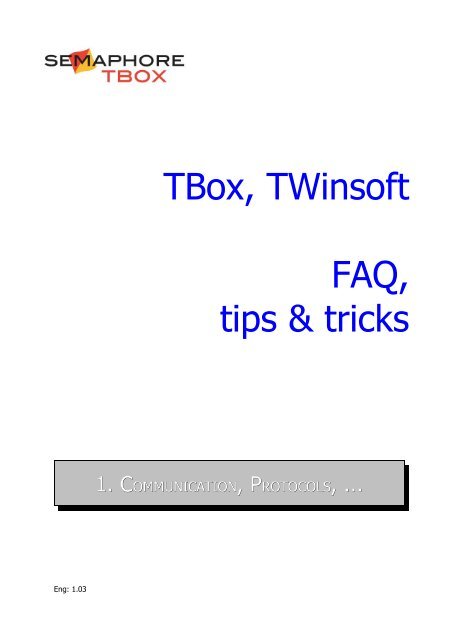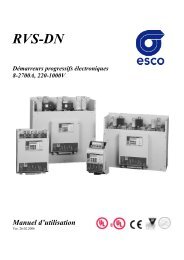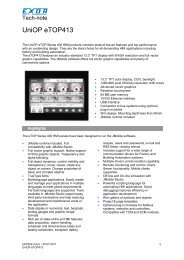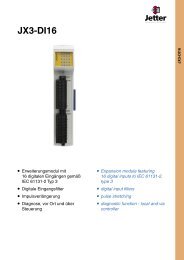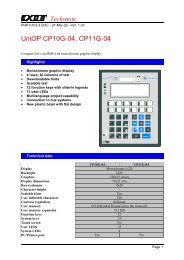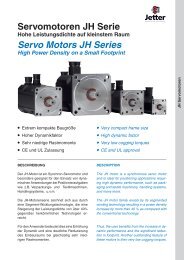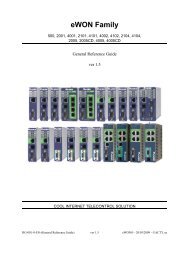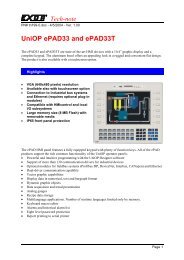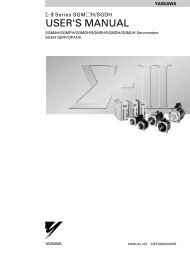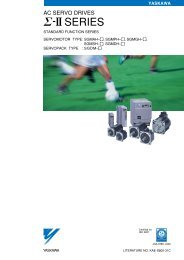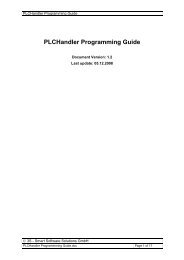You also want an ePaper? Increase the reach of your titles
YUMPU automatically turns print PDFs into web optimized ePapers that Google loves.
Eng: 1.03<br />
TBox, TWinsoft<br />
<strong>FAQ</strong>,<br />
tips & tricks<br />
1. COMMUNICATION<br />
COMMUNICATION,<br />
, PROTOCOLS PROTOCOLS,<br />
, ...
Disclaimer<br />
Every effort has been made to ensure the accuracy of the information in this guide. However, Semaphore. assumes<br />
no responsibility for the accuracy of the information. Product information is subject to change without notice.<br />
<strong>TWinSoft</strong> and A are registered trademark of Semaphore.<br />
Windows is a trademark of Microsoft Corp.<br />
Copyright<br />
© 2007-2008 by<br />
Chaussée de Bruxelles, 732a<br />
B-1410 Waterloo<br />
Edition: September 18, 2007<br />
Author: Jean Burton<br />
Version: 1.03 <strong>FAQ</strong>, tips & tricks – COMMUNICATION 2
TABLE OF CONTENTS<br />
INTRODUCTION.....................................................................................................................................5<br />
1. RESTORE COMMUNICATION WITH TBOX-MS / TBOX-LITE................................................6<br />
1.1.INTRODUCTION..............................................................................................................................6<br />
1.2.GLOBAL RESET.............................................................................................................................7<br />
1.3.TOTAL RESET...............................................................................................................................8<br />
1.4. GLOBAL RESET WITH TBOX-CPU3.................................................................................................9<br />
2. MODBUS VS. J-BUS ADDRESSING ISSUE...................................................................................10<br />
2.1. INTRODUCTION...........................................................................................................................10<br />
2.2. ADDRESS PREFIX (MODICON STANDARD).........................................................................................10<br />
2.3. ADDRESS OFFSET (MODICON STANDARD)........................................................................................10<br />
2.4.MODBUS ADDRESSING OF TAGS IN TBOX.........................................................................................11<br />
2.5. ACCESSING REMOTE DEVICE FROM TBOX.......................................................................................11<br />
2.6.ACCESSING TBOX FROM AN EXTERNAL DEVICE (HMI, SCADA, PLC, ...).............................................12<br />
2.7. ABOUT HARDWARE.....................................................................................................................12<br />
3. CREATING A REMOTE TAG 'SERIAL': STEP BY STEP...........................................................13<br />
3.1.SET THE COMMUNICATION CHANNEL..................................................................................................13<br />
3.2.CREATE THE REMOTE DEVICE........................................................................................................13<br />
3.3.CREATE THE TAG........................................................................................................................14<br />
3.4.CREATE THE REMOTE TAG............................................................................................................14<br />
3.5.TESTING....................................................................................................................................15<br />
3.6. BLOCK COMMUNICATION..............................................................................................................15<br />
4. REMOTE TAG: TBOX TAG VS. QUANTITY OF VARIABLES.................................................16<br />
4.1. WITH ANALOG TAGS...................................................................................................................16<br />
4.2. WITH DIGITAL TAGS...................................................................................................................17<br />
5. MODBUS: HANDLING 32 BITS VARIABLES...............................................................................18<br />
6. MODBUS ADDR. ISSUE WHEN CONNECTING TO MODBUS DEVICES (EXOR, HMI, ...).19<br />
6.1. EXOR WORKS AUTOMATICALLY WITH ‘BLOCK COMMUNICATION’.............................................................19<br />
6.2. WORKING WITH ANALOG VARIABLES.................................................................................................20<br />
6.3. WORKING WITH 32 BITS VARIABLES................................................................................................20<br />
6.4. DIFFERENCE BETWEEN TBOX-MS -LITE AND TBOX CPU3..............................................................20<br />
7.COMMUNICATION ERROR – MODBUS EXCEPTIONS.............................................................21<br />
8. TWINSOFT IS UNABLE TO OPEN A SERIAL PORT..................................................................22<br />
9. TESTING COMMUNICATION WITH TBOX................................................................................23<br />
9.1.LEDS OF COMMUNICATION PORT.....................................................................................................23<br />
Version: 1.03 <strong>FAQ</strong>, tips & tricks – COMMUNICATION 3
10. IP SETTING ISSUES OF THE TBOX............................................................................................24<br />
1. IP address..........................................................................................................................................24<br />
2. IP subnet............................................................................................................................................24<br />
3. Gateway address................................................................................................................................25<br />
4. IP addresses handling in TBox MS and TBox LITE...........................................................................25<br />
11. INTERFACING TO SCADA. CLARIFICATION ABOUT OPC.................................................26<br />
12. TRANSMISSION TIME IN MODBUS PROTOCOL....................................................................28<br />
12.1. BLOCK COMMUNICATION............................................................................................................28<br />
12.2.TRANSMISSION TIME...................................................................................................................28<br />
13.TCP/IP HIGH END DEBUG USING “WIRESHARK”..................................................................29<br />
14. IP ADDRESS AND MAC ADDRESS ARP TABLE.......................................................................31<br />
Version: 1.03 <strong>FAQ</strong>, tips & tricks – COMMUNICATION 4
Introduction<br />
The goal of the <strong>FAQ</strong> document is to provide detailed explanations on specific topics, to insist on<br />
certain points and to answer regular questions.<br />
It does not provide general information on how using TBox, but it can help you to solve<br />
selective problems while developing a project.<br />
In order to help you finding the information, the <strong>FAQ</strong> are divided into different manuals:<br />
TBox/<strong>TWinSoft</strong> <strong>FAQ</strong> documents:<br />
1. <strong>Communication</strong>: general information about ModBus, local communication (this<br />
document)<br />
2. Modem: all you want to know about dial-up connection<br />
3. Miscellaneous: all the rest (coming soon)<br />
You will also find <strong>FAQ</strong> document about WebForm Studio and TView.<br />
All those documents available at: http://tbox.biz/uk/telecharg.php --> <strong>FAQ</strong>/Technical Notes<br />
There is no hierarchy between the different topics. Unless specified, each topic can be read<br />
independently from the others.<br />
Version: 1.03 <strong>FAQ</strong>, tips & tricks – COMMUNICATION 5
1. Restore <strong>Communication</strong> with TBox-MS / TBox-LITE<br />
This topic describes how to restore a communication with a TBox and how the firmware and<br />
application levels are organized in the RTU.<br />
1.1. Introduction<br />
In some cases, it may happen you cannot communicate anymore with your RTU, because you<br />
don't know the settings of the com. port of TBox you are connected to (Baudrate or IP settings<br />
and/or protocol).<br />
To test the communication, you use the menu “<strong>Communication</strong>” “RTU identification”. If it<br />
does not show you anything, it means you are not communicating with your TBox.<br />
To restore communication, you can set the RTU to a known, default configuration.<br />
This is called the global reset of the RTU: you stop the application running in the RTU.<br />
This operation does not erase the application, but stops it.<br />
A single push on the 'Reset' button will restart the application.<br />
The procedure for TBox CPU-3 is explained at chapter 1.4.<br />
Previous to act on the application, let's see how the different software levels are organized in<br />
TBox.<br />
The software is organized in three levels, with:<br />
Application<br />
O.S.<br />
Loader<br />
1. the application<br />
it corresponds to the development done with <strong>TWinSoft</strong><br />
2. the O.S. (Operating System)<br />
it contains all features on TBox (alarms, datalogging, process, TCP/IP, ...)<br />
3. the loader<br />
it handles local communication in ModBus protocol<br />
Version: 1.03 <strong>FAQ</strong>, tips & tricks – COMMUNICATION 6
1.2. Global reset<br />
With TBox MS and TBox LITE you maintain the reset button to ‘Reset’ position and let the<br />
LED 'Run' flashes 3 times. You release then the button. The application stops and the RTU<br />
runs with the Operating System (O.S.).<br />
The LED 'Run' flashing at ½ Hz indicates the application is stopped.<br />
Application<br />
O.S.<br />
Loader<br />
Factory OS settings:<br />
- Station address (ModBus)= 1<br />
- Serial ports = 9600, N, 8, 1 - protocol: ModBus-RTU<br />
- IP address = 192.168.1.99 - protocol: ModBus/TCP<br />
Once the global reset has been carried out, you adapt <strong>TWinSoft</strong> “PC Setup” (from the main<br />
menu “<strong>Communication</strong>”) to the current TBox configuration (see O.S. settings above).<br />
Then you test communication doing<br />
from the main menu,<br />
<strong>Communication</strong> RTU<br />
identification.<br />
The following information (adapted<br />
to the model of TBox you are using)<br />
must be display:<br />
Then you can send your own program, with new communication settings.<br />
If you had sent the sources of the application to the RTU, you can then also retrieve it from<br />
the menu “<strong>Communication</strong> “Download” Program sources”.<br />
If you wish to re-start you the RTU, without modification, press the button once to the<br />
'Reset' position. The application restarts.<br />
Version: 1.03 <strong>FAQ</strong>, tips & tricks – COMMUNICATION 7
1.3. Total reset<br />
The total reset may be needed in very rare situation, but at least you will understand what<br />
happens if you press longer the button 'Reset'.<br />
To carry our a total reset, you maintain the reset button to ‘Reset’ position and let the LED<br />
'Run' flashes 5 times.<br />
The RTU is back to the loader level (below the O.S. level). In this mode, you can only send<br />
an OS to the RTU (“<strong>Communication</strong>” “Upload” “Operating System”.<br />
Application<br />
O.S.<br />
Loader<br />
Factory Loader settings:<br />
- Station address (ModBus)= 1<br />
- Serial ports = 9600, N, 8, 1 - protocol: ModBus-RTU<br />
- IP address = NO Ethernet available<br />
As you can see, you can only communicate through serial port.<br />
Then you test communication<br />
doing from the main menu,<br />
communication RTU<br />
identification.<br />
The following information<br />
(adapted to the model of TBox you<br />
are using) must be displayed:<br />
If you change your mind just after the reset, press the button once to the 'Reset'<br />
position. The O.S. and application will restart.<br />
Version: 1.03 <strong>FAQ</strong>, tips & tricks – COMMUNICATION 8
1.4. Global Reset with TBox-CPU3<br />
With previous generation of CPU, the philosophy of Global Reset and Total Reset are similar,<br />
but the way to achieve them is slightly different.<br />
You will use the two small push buttons on the front “PGM” and “RST”:<br />
– Press and Hold “PGM”<br />
– Press and Release “RST”<br />
– Let the LEDs flash 2 times (4 times for the Total Reset)<br />
– Release “PGM”<br />
The LED “USR”, after a Global Reset, must be flashing at ½ Hz.<br />
Features “O.S.” settings “Loader” settings<br />
Station address<br />
COM1, COM2, COM3<br />
COM4 - PSTN<br />
COM5 - PCMCIA<br />
COM5 - PSTN<br />
Protocol<br />
Ethernet<br />
9600, E, 8, 1<br />
V22<br />
V34<br />
V34<br />
ModBus-RTU<br />
NO Ethernet<br />
1<br />
9600, E, 8, 1<br />
V22<br />
Not available (*)<br />
Not available<br />
ModBus-RTU<br />
NO Ethernet<br />
(*): the modem will pick-up the line and synchronize, but there is NO communication.<br />
Version: 1.03 <strong>FAQ</strong>, tips & tricks – COMMUNICATION 9
2. ModBus vs. J-Bus Addressing issue<br />
This topic describes basics in ModBus protocol addressing.<br />
2.1. Introduction<br />
ModBus is a very simple protocol and very easy to communicate with. It is based on:<br />
- Station number (0 .. 255)<br />
- Function index (standard functions: 1, 2, 3, 4, 5, 15, 16) (read, write, digital, analog,<br />
simple, ....)<br />
- Address (0.. 65535)<br />
Historically, Modicon created ModBus-RTU protocol and was the only one that could use it.<br />
Other companies should use J-Bus (differences explained below)<br />
To make things clearer for their users (!), Modicon fixed some rules.<br />
2.2. Address prefix (Modicon Standard)<br />
As a PREFIX of the address, they indicate an index, telling which kind of variable is concerned:<br />
Examples: Prefix '0' Coil<br />
Prefix '1' Digital Input<br />
Prefix '4' Holding register<br />
Then following this prefix, they decided that the ModBus address would have maximum 4<br />
characters: 0000 9999.<br />
Examples:<br />
1xxxx = addressing a digital input<br />
4xxxx = addressing an analog register<br />
2.3. Address offset (Modicon Standard)<br />
They decided that the first address '0' would become '1'.<br />
This has given the distinction between ModBus (start at '1') and J-Bus (start at '0').<br />
ModBus (Modicon) and J-BUS are identical, and every one speaks commonly of ModBus.<br />
But to be exact, TBox supports J-Bus.<br />
Example:<br />
If you have a SCADA using the 2 rules presented above, if you want for instance to read the<br />
TBox analog register at address 123, you will indicate in the SCADA with the Modicon syntax:<br />
40124.<br />
But the real address (used in the transaction) is 123. The prefix “4” is not part of the<br />
address.<br />
Version: 1.03 <strong>FAQ</strong>, tips & tricks – COMMUNICATION 10
2.4. ModBus addressing of Tags in TBox<br />
The ModBus address of variables in TBox is always a REAL address (NO prefix, NO offset).<br />
ModBus addressing of Tags depends on the family of TBox.<br />
With CPU-3:<br />
All variables have predefined address you cannot change.<br />
Examples:<br />
second=22016<br />
AIR0=20480<br />
Ana0 of the CPU=64<br />
Float0=23040<br />
With TBox-MS, -LITE, -LP:<br />
All variables can be assigned any free ModBus address:<br />
2.5. Accessing Remote Device from TBox<br />
To read/write data in external devices with TBox, you use Remote Tags (see details chapter 3.)<br />
The external variable you want to read/write is indicated into the Remote Tags with its real<br />
ModBus address.<br />
Depending on the documentation you receive from the manufacturer, you may have to adapt<br />
the addressing indicated into the manual.<br />
The trick is to try different addresses, one by one: adding 1 unit, removing 1 unit, removing<br />
possible prefix, ...<br />
Version: 1.03 <strong>FAQ</strong>, tips & tricks – COMMUNICATION 11
2.6. Accessing TBox from an external device (HMI, SCADA,<br />
PLC, ...)<br />
When an external device using Modicon standard has to access TBox, the format of the address<br />
(max. 4 or 5 digits) might be an issue.<br />
Working with CPU-3<br />
If the format of addresses supported by the SCADA allows only 4 digits, you have to use the<br />
driver “NewMap” to remap the addresses to 0000 9999, as the addresses in CPU-3 are<br />
fixed.<br />
Working with TBox MS and TBox LITE<br />
There is no problem as you can adapt ModBus address for each Tag (see above).<br />
Think also about the prefix and the offset. If your SCADA uses the genuine Modicon syntax, the<br />
address might be like: 4xxxx (to access an analog variable), or 1xxxx to access a digital<br />
input, ... If the SCADA uses an offset: xxxx=TBox Tag address + 1<br />
2.7. About Hardware<br />
Sometimes there are also hardware problems, linked to the fact that one device answers too<br />
fast, or that a Remote Device reacts too slow, because communication is not its main task.<br />
- TBox working as a 'slave',<br />
if TBox answers too fast for the Master, this can be adjusted by<br />
increasing its 'end of frame detection' of the COM port, in COM port 'Advanced'<br />
parameters.<br />
For instance 50 msec. or more.<br />
As of <strong>TWinSoft</strong> 10.xx and OS 3.14.xxx, the 'end of Frame' detection is replaced by<br />
'Incoming Frame Detection' and works in automatic.<br />
- TBox working as a 'master',<br />
to avoid TBox starting transactions one after each others to<br />
quickly, when for instance one 'slave' is still in the answering phase, you can add an<br />
'IFG' (Inter Frame Gap).<br />
We suggest IFG should be of minimum 10 ms. (8 ms. With CPU3)<br />
Version: 1.03 <strong>FAQ</strong>, tips & tricks – COMMUNICATION 12
3. Creating a Remote Tag 'Serial': Step by Step<br />
This topic describes how to establish a communication between TBox and another ModBus<br />
device; typically another TBox.<br />
Do a new clean project!<br />
3.1. Set the communication channel<br />
- From the 'Resources', go to<br />
the tab 'Parameters' of the<br />
com. port you will use.<br />
- Select the same Baudrate as<br />
the one of the device you are<br />
connected to. You must<br />
KNOW it, don’t guess it!<br />
- Select the same data, parity<br />
and stop bits as the device.<br />
You must KNOW them.<br />
- Select the protocol : ModBus-<br />
RTU<br />
- In the tab 'Advanced', declare<br />
an inter-frame gap of 10 ms.<br />
- Tag the communication<br />
variable from the COM port,<br />
tab 'DCV', 'ComX.Noreply'<br />
3.2. Create the Remote Device<br />
From the “Resources” “List of I/O”,<br />
create a “block of I/O”<br />
- Select “ModBus Device”<br />
- Type the Station ModBus address of the<br />
slave<br />
- Select the COM port of the TBox<br />
connected to the device<br />
example: COM2 - RS485 of CPU<br />
- Select a digital Tag (internal variable)<br />
used as Trigger, to activate the<br />
communication. Select the condition<br />
“High State”.<br />
The Tag must be initialized to 1.<br />
Example using COM2 – RS485 of MS-CPU16<br />
Version: 1.03 <strong>FAQ</strong>, tips & tricks – COMMUNICATION 13
3.3. Create the Tag<br />
In the below example, the Tag will receive ONE analog value read from the device (let's start<br />
with one!).<br />
You have to know the format of the Tag you want to read in the device (8bits, 16bits,<br />
32bits, float?) and create a Tag with the same format in your <strong>TWinSoft</strong> project.<br />
Don’t guess the type, you must know it!<br />
Concerning Analog Tags, as ModBus only defines addresses of 16bits variable, if the Tag<br />
you select is of format 32bits, TBox will automatically build a request for 2 addresses.<br />
3.4. Create the Remote Tag<br />
A Remote Tag corresponds to a transaction with a Remote Device. It associates a TBox Tag to<br />
an address in a Remote device.<br />
In the Remote Tags folder of the <strong>TWinSoft</strong> project, create ONE Remote Tag.<br />
- select the Tag you have created (see above).<br />
- select READ.<br />
- Quantity=1.<br />
- Select the remote device you want to read.<br />
- Chose the type of register you read: Don’t guess it!<br />
Click “Help” to choose the type. A table associates the types with ModBus Functions. If you<br />
chose the wrong one, you may have communication errors!<br />
Check in the documentation of the device to verify which ModBus functions are supported.<br />
Don’t guess it!<br />
- Select the address of the remote device you want to read: if the device uses Modicon<br />
standard, remove the prefix of the address and subtract 1 from the address number: eg.<br />
3041 -> 40 (see also chapter 2. above).<br />
Version: 1.03 <strong>FAQ</strong>, tips & tricks – COMMUNICATION 14
3.5. Testing<br />
Cable the TBox to the remote device.<br />
Check if the remote device has the same port settings and is in Slave mode, it means it has no<br />
'Master' configuration.<br />
Check also the pin out correspondence for the RS485 between the slave and the TBox.<br />
Upload the project in the TBox and look at the LED<br />
if the cabling is good, TxD of the TBox must blink to indicate the sending of request.<br />
If RxD is blinking, it means that Modbus frames are returned by the device<br />
Results<br />
To check if TBox receives a value, try to change its value using the key in the list of Tags.<br />
If the value you type is maintained, there is no communication.<br />
If you have 'ComX.Noreply' = 1, it means you do not have right communication (time out,<br />
wrong cabling, wrong CRC for the frame)<br />
This variable is SET by the OS. Reset it ( in the list of Tags) and check it again.<br />
3.6. Block <strong>Communication</strong><br />
You can also try a block communication as some devices only answer by block of 8<br />
addresses especially when transferring digital data:<br />
- Create 8 Tags of the SAME TYPE with SUCCESSIVE ModBus addresses in TBox<br />
- In the Remote Tag you declare as Tag the FIRST one and quantity to 8<br />
- In the Address field, type the ModBus address of the FIRST variable in the slave<br />
(corresponding to the first of a block of 8 SUCCESSIVE addresses), having the SAME TYPE<br />
as the one of the Tags in TBox.<br />
Upload the project in TBox and check that the LED RxD and TxD of the RS485 port blink. Then<br />
check with <strong>TWinSoft</strong> the value of the Tags.<br />
Version: 1.03 <strong>FAQ</strong>, tips & tricks – COMMUNICATION 15
4. Remote Tag: TBox Tag vs. Quantity of Variables<br />
Chapter 3. above describes the principle of Remote Tags. This topic describes the relation<br />
between the formats of Tag (8bits, 16bits, 32bits, Float) and the quantity.<br />
4.1. With Analog Tags<br />
ModBus protocol is built on 'Bytes', and as far as analog is concerned, it defines the way of<br />
transferring 16 bits variables.<br />
Each 16 bits variable corresponds to ONE ModBus address.<br />
But with ModBus it is possible to exchange 32 bits variables like DWORD or FLOAT<br />
If you want to exchange DWORD or FLOAT, see also chapter 5. about Handling 32 bits<br />
variables).<br />
In Remote Tag configuration of a Analog Tags, the quantity relates to number of variables (not<br />
to ModBus addresses).<br />
Examples:<br />
Operation / Qty / Format ModBus addresses<br />
of the TBox Tags<br />
Read / 8 / 16 bits 20480<br />
20481<br />
20482<br />
20483<br />
20484<br />
20485<br />
20486<br />
20487<br />
Read / 4 / Floats 22400<br />
22402<br />
22404<br />
22406<br />
Write / 2 / 32 bits 1000<br />
1002<br />
ModBus addresses<br />
in Remote Device<br />
1200<br />
1201<br />
1202<br />
1203<br />
1204<br />
1205<br />
1206<br />
1207<br />
600<br />
602<br />
604<br />
606<br />
20000<br />
20002<br />
ModBus addresses are chosen as example<br />
Remarks<br />
Successive ModBus<br />
addresses, one by one.<br />
Successive even<br />
addresses, as 32bits<br />
variables need TWO<br />
addresses.<br />
Successive even<br />
addresses, as 32bits<br />
variables need TWO<br />
addresses.<br />
You see how important it is that the format of the Tags of TBox must be the same as the<br />
format of the variables you want to retrieve!<br />
Version: 1.03 <strong>FAQ</strong>, tips & tricks – COMMUNICATION 16
4.2. With Digital Tags<br />
ModBus protocol is based on 'Bytes', and as far as digital is concerned, it transfers digital<br />
information through Byte(s) (= 8 bits).<br />
Each Bit corresponds to ONE ModBus address.<br />
ModBus protocol supports transfer of less than 8 bits. In this case, some bits are not<br />
interpreted.<br />
In Remote Tag configuration of Digital Tags, the quantity relates to number of bits (= ModBus<br />
addresses).<br />
Working with quantity higher than 8, be sure that everything is multiple of 8:<br />
– ModBus address of the First Tag<br />
– Quantity<br />
– ModBus address of the first variable to access in the remote device.<br />
With Digital or Analog, check there is no gap in ModBus addresses when working with<br />
blocks (Quantity > 1).<br />
Reading block data to TBox MS and TBox LITE (as Slave), if all Tags have not been<br />
created it will lead to communication errors.<br />
Version: 1.03 <strong>FAQ</strong>, tips & tricks – COMMUNICATION 17
5. ModBus: handling 32 bits variables<br />
This topic describes how TBox uses ModBus protocol to handle 32 bits variables.<br />
The ModBus protocol description does not specify anything regarding 32 bits registers.<br />
The protocol based on transfer of , describes only 'Boolean' and '16 bits' data<br />
transmission.<br />
Therefore, transmission of 32 bits is declared as 2 x 16 bits transmission, corresponding<br />
internally to 2 x ModBus addresses. Then each manufacturer has to determine a way of<br />
organizing the bytes with 2 possibilities: Little Endian or Big Endian.<br />
With TBox families and associated software's (<strong>TWinSoft</strong>, TView, TComm, ...), bytes are<br />
transferred in order HI to LO, the same as when transferring a 16 bits (corresponding to Big<br />
Endian):<br />
- 16 bits: , , <br />
- 32 bits: , , <br />
Example with a Floating point register: ModBus addresses are chosen as example<br />
Float value : 0.02<br />
Value in hex.: 3CA3D70A<br />
Hi Word: 3CA3 (ModBus address 100)<br />
Lo Word: D70A (ModBus address 101)<br />
In the frame: ......<br />
From HMI, this way of addressing 32 bits is sometime indicated:<br />
INV FLOAT and INV DWORD<br />
In case an external device connected to TBox works “from the other side” (little endian), you<br />
have to invert data of both addresses using BASIC functions ‘Split32’ and ‘Pack32’:<br />
' Splitting the 32 variables to two 16 bits registers<br />
Split32(Input,High_W,Low_W)<br />
' Packing the two 16 bits registers in the other side.<br />
Pack32(Output,Low_W,High_W)<br />
Version: 1.03 <strong>FAQ</strong>, tips & tricks – COMMUNICATION 18
6. ModBus Addr. Issue when Connecting to ModBus<br />
Devices (EXOR, HMI, ...)<br />
This topic answers questions on how addressing TBox variables in HMI, with EXOR UniOp as<br />
example.<br />
This is a general discussion regarding block read and write from any ModBus device to TBox.<br />
Here is the situation when working with EXOR UniOp, an operator panel that can be supplied<br />
with TBox.<br />
The same rules can be applied to any ModBus HMI.<br />
The issues relate to the connection between Tags in the HMI and Tags in the TBox.<br />
Some basic rules have to be respected.<br />
➢ Working with TBox MS and TBox LITE, ModBus addresses of their Tags are not fixed.<br />
For each Tag, you can change its ModBus address.<br />
➢ Creating Analog Variables you can also define their format (8 bits, 16 bits, 32 bits or<br />
Float).<br />
In order to have the best performance with EXOR, you should be careful about the following<br />
points.<br />
6.1. EXOR works automatically with ‘block communication’<br />
Working with digital Tags: always be sure that you have defined in <strong>TWinSoft</strong> blocks of 8<br />
consecutive ModBus addresses, starting at a multiple of 8.<br />
Example: you have 9 digital inputs you want to display in EXOR.<br />
EXOR will ask TBox values for 16 addresses, starting at the first one which must be<br />
multiple of 8.<br />
Check in the TBox application the first one has an address multiple of 8 and that<br />
you have created Tags to have a total of 16 successive ModBus addresses.<br />
Working with Analog Tags: always be sure that you have defined in the TBox application Tags<br />
with consecutive ModBus addresses. When it is possible, EXOR builds automatically a block<br />
from the first ModBus address until the last ModBus address. You can’t leave a gap in the TBox<br />
addresses.<br />
Be careful of the Floats/32 bits limitation in a communication block of TBox CPU3. Indeed,<br />
the maximum quantity of floats/32 bits that the TBoxCPU3 can manage in a communication<br />
block is 8. For example, if you read the floats 4, 8 and 13, EXOR makes a block of 9 too big<br />
for the CPU3. The solution is working without communication block using the option “No data<br />
blocks” in “Project configure controllers select protocol controller setup”.<br />
If one of those rules is not respected, EXOR will return communication errors.<br />
Version: 1.03 <strong>FAQ</strong>, tips & tricks – COMMUNICATION 19
6.2. Working with analog variables<br />
Check you have a block of variables of similar type (16 bits, float,…) with consecutive<br />
ModBus addresses.<br />
6.3. Working with 32 bits variables<br />
For such data, there are two ways of interpreting the data: from left to right and from right to<br />
left. TBox interprets the 4 bytes of 32 bits from left to right (also known as Big endian).<br />
In case the HMI interprets them in another order, you should use BASIC functions ‘Split32’ and<br />
‘Pack32’ to reorder the bytes (see chapter 5. above).<br />
Concerning EXOR:<br />
– to display ‘Float variables’ you should select the Data field format: INV FLOAT<br />
– to display ‘Long-32 bits’ select the Data field format: INV DBL WORD<br />
It is always possible to change EXOR communication settings to work without block<br />
communication (see EXOR manual, chapter 4.: PLC Setting PLC Comm…), but for<br />
performance reason, we advise to keep block communication and adapt Tag settings<br />
in <strong>TWinSoft</strong>.<br />
6.4. Difference between TBox-MS -LITE and TBox CPU3<br />
In TBox CPU-3, all ModBus addresses exist by default. Then, even if you have not tagged<br />
variables (I/O, AIR, DIR, STO, ...), the ModBus addresses exist.<br />
Version: 1.03 <strong>FAQ</strong>, tips & tricks – COMMUNICATION 20
7. <strong>Communication</strong> Error – Modbus Exceptions<br />
This topic explains the principle of communication error codes called “Exception Codes”<br />
When a bad request is sent to a TBox MS and TBox LITE (TBox = Slave), it responds with<br />
error codes (called exception codes). This helps you to find which parameter is wrong.<br />
Byte 0 : The Station address of the RTU<br />
Byte 1 : Modbus function in error + 80h<br />
Byte 2 : Code which specifies the error<br />
Byte 4 : CRC16 High<br />
Byte 5 : CRC16 Low<br />
Example :<br />
01 Illegal function<br />
02 Illegal data address (Modbus address)<br />
03 Illegal data value<br />
04 Slave device failure<br />
05 Acknowledge<br />
06 Slave device busy<br />
07 Negative acknowledge<br />
08 Memory parity error<br />
The master sends 01 04 50 00 00 01 20 CA<br />
In details: 01 = Slave device Modbus address<br />
04 = Modbus function (Read analog variables)<br />
50 00 = Tag Modbus address (50 00 h = 20480 d)<br />
00 01 = Quantity<br />
20 CA = CRC16<br />
The slave responds the following exception code 01 84 02 C2 C1<br />
In details: 01 = Slave device Modbus address<br />
84 = Modbus function (04) + 80 h<br />
02 = Illegal data address<br />
C2 C1 = CRC16<br />
Conclusion : The master tries to read a Tag with unknown ModBus address. Typically, when<br />
using TBox MS and TBox LITE, it correspond to a missing Tag in your TWinsoft program.<br />
To understand how the Modbus protocol work, you can use the free software<br />
“ModBus tester” available on our website :<br />
“http://www.tboxsupport.biz/free_downloads/ModBusRTUTester.exe”<br />
Version: 1.03 <strong>FAQ</strong>, tips & tricks – COMMUNICATION 21
8. <strong>TWinSoft</strong> is Unable to Open a serial Port<br />
This topic relates to <strong>TWinSoft</strong> PC Setup and relation between <strong>TWinSoft</strong> and Windows.<br />
Setting <strong>TWinSoft</strong> to communicate with a serial port (from the menu “PC Setup”), it may happen<br />
that you receive the message: ”<strong>TWinSoft</strong> is Unable to Open the <strong>Communication</strong> Port’’.<br />
It usually means the <strong>Communication</strong> port has already been captured by another Windows<br />
application.<br />
You must verify if you do not run another application using the same serial port. If you do not<br />
find anyone, you must open the ‘Windows Task Manager’ (press Ctrl+Alt+Del) and verify in the<br />
‘Applications’ tab, then in the ‘Processes’ tab, that that there is no <strong>TWinSoft</strong>, TView,<br />
Hyperterminal, ... process already running (former processes that have not been closed<br />
properly by Windows).<br />
If it is the case, close the process(es).<br />
Some programs, like PLC programs may have installed a driver that takes over the serial<br />
port. In such case, the driver should be disabled.<br />
If you removed all the applications using the communication port which were running, you<br />
should be able to use the port in <strong>TWinSoft</strong> again.<br />
If this still does not work, reboot the PC and start <strong>TWinSoft</strong> before any other task.<br />
Working with USB Serial interface, be sure of the ID of the COM corresponds to<br />
the one you are using.<br />
Version: 1.03 <strong>FAQ</strong>, tips & tricks – COMMUNICATION 22
9. Testing communication with TBox<br />
This topic illustrates how you can use '<strong>Communication</strong> Variables'.<br />
TBox provides diagnostic variables to monitor communications. For each communication port,<br />
TBox provides internal variables indicating different status of the port.<br />
Working with TBox MS and TBox LITE those variables are accessible from the tabs 'DCV' and<br />
'ACV' of each communication port.<br />
Working with CPU-3, those informations are available from the “Resources” “Digital and<br />
Analog Special Registers”.<br />
Example with TBox MS16 of testing on COM2 (RS485) the quantity of communication errors<br />
and the time the communication error lasts. The variable used is the DCV [Com2.NoReply]<br />
Alarms and Datalogging<br />
You can combine those tests with alarms and datalogging features.<br />
For instance with the above example, the Tag 'Timer1_Status' could be declared as digital<br />
chronology and/or Alarm condition.<br />
9.1. LEDs of communication port<br />
LEDs are very useful as first verification of communication validity:<br />
➢ With TBox MS each serial port and modem are equipped with individual Tx and Rx<br />
LED.<br />
➢ With TBox CPU-3, there are common LED Tx and Rx for all communication ports,<br />
except Ethernet port.<br />
To test ONE port, you should remove connector of the other ports.<br />
Version: 1.03 <strong>FAQ</strong>, tips & tricks – COMMUNICATION 23
10. IP Setting issues of the TBox<br />
This topic answers basic questions related to IP addresses in TBox.<br />
1. IP address<br />
Each port (all interfaces included) must have a unique IP address<br />
In case you don't follow this rule, result might be unpredictable and might cause lots of<br />
communication trouble.<br />
TBox does not support DHCP (dynamic IP addressing). TBox requires for any of its Ethernet<br />
port, a fix IP address.<br />
2. IP subnet<br />
Be sure the different interfaces are defined into different subnets.<br />
The possible interfaces are: Ethernet of the MS-CPU16, each Ethernet of MS-CPU32, MS-<br />
ETHER, MS-ETHER4, modem.<br />
The subnet is built from the IP address and the subnet mask.<br />
Example:<br />
IP: 192.168.1.99<br />
Mask: 255.255.255.0<br />
The subnet: 192.168.1.xxx (any address in the range 192.168.1.xxx).<br />
About the modem subnet, it<br />
concerns the RTU acting in<br />
'Server' mode (receiving call).<br />
You access its configuration<br />
from the Advanced RTU<br />
properties TCP/IP.<br />
Define a range which is in a<br />
different subnet than any<br />
Ethernet Port of the CPU.<br />
Version: 1.03 <strong>FAQ</strong>, tips & tricks – COMMUNICATION 24
3. Gateway address<br />
You need the Gateway address for outgoing 'Client' connection, to access an IP address which<br />
is not in the current subnet. For instance when sending e-mail or FTP using an external<br />
Server.<br />
The gateway address is always<br />
in the same subnet as the IP<br />
address<br />
4. IP addresses handling in TBox MS and TBox LITE<br />
IP Forwarding is one of the features of TBox MS and TBox LITE . IP forwarding uses the<br />
following rules:<br />
➢ If you send a request to an existing IP address of the subnet, the device will answer.<br />
➢ If you send a request to an unknown IP address, AND IP Forwarding is not activated,<br />
the request is lost.<br />
➢ If you send a request to an unknown IP address, AND IP Forwarding is activated, the IP<br />
address is tested with all interfaces, starting with the CPU.<br />
If IP address fits with an interface, the interface will answer (like point 1. here above).<br />
Otherwise, the request is lost.<br />
The same in a “computing” format:<br />
1. If (Dest.IP == Netif.IP) then OK --> TCP/UDP, ... else 2.<br />
2. If (IP Forward?) then 3. else Discard.<br />
3. For (all NetIf's)<br />
if (Dest.IP & NetIf.Subnet?)<br />
if (Dest.IP==NetIf.IP) then OK --> TCP/UDP, ...<br />
else IP Output --> Forward<br />
next for<br />
Discard<br />
Dest= Destination<br />
NetIf= Network Interface<br />
Version: 1.03 <strong>FAQ</strong>, tips & tricks – COMMUNICATION 25
11. Interfacing to SCADA. Clarification about OPC<br />
This topic presents different ways a SCADA software can communicate with TBox.<br />
TBox's native language is ModBus (RTU, ASCII, TCP).<br />
For Tag sampling, TBox uses standard ModBus functions, but as TBox supports<br />
datalogging and alarming, some extra ModBus functions that support time-stamping have<br />
been implemented.<br />
Then, the protocol TBox uses could actually be renamed "time-stamped ModBus".<br />
If a SCADA software wants to communicate with a T TBox and only read locally on-line values,<br />
then you can use standard ModBus protocol (to be more accurate: "J-Bus" protocol. See<br />
chapter 2. above).<br />
Note also that besides embedded ModBus protocols, TBox supports other standard SCADA<br />
protocols: IEC-60870-5-101, -104, DNP3.0, TG800, DF1 serial.<br />
If any customer or SCADA software editor wants to interface their software to TBox and be able<br />
to retrieve historical database or alarms, they have several options.<br />
1. First solution is to write a new driver from scratch knowing the custom functions and<br />
memory organization. This is hard work and the customer should sign a non disclosure<br />
agreement. The disadvantage of this method is also that if we make any change in the<br />
TBox features, or memory organization in the future or if we add new hardware, the<br />
developer will have to develop new code and will have to recompile the whole thing.<br />
For those reasons, we don’t allow users to do this. See next solution.<br />
2. Second solution is to use the "TCOMM.dll" library. The TCOMM handles all difficult<br />
part of the download mechanisms for the programmer so the development of a TBox<br />
interface becomes much easier. One limitation: TCOMM supports only Windows<br />
environment, so no Linux, no Unix...<br />
TCOMM is free of charge and can be downloaded from our WEB site at:<br />
http://tbox.biz/TComm/TComm_dll.php. On this WEB page, you'll find an executable file<br />
that will unzip the library files and gives you the appropriate technical documentation<br />
(PDF format), examples on how to implement the API's in your SCADA.<br />
NOTE: TCOMM does not handle the dial up features to the outstations. Those features<br />
must still be implemented on the SCADA side.<br />
The following SCADA manufacturers have already implemented the complete TBox driver<br />
using TCOMM: Wizcon (Axeda – USA), Factorylink (USData - USA), Citect (Citect -<br />
Australia: driver developed by the french distributor of Citect), Cimview (Aspentech - USA),<br />
Winlab (Germany), Topkapi (Areal - France), Tablegrabber (Projex - The Netherlands),<br />
Acron Connect (Dataforum - Germany), ViewStar (Cegelec - Germany), Cube (Orsi-Siemens<br />
- Italy), PView (Endress+Hauser - Italy), Comsat (Onyx-T+ - France), LabView (National<br />
Instruments - USA), PANORAMA (France). Most of those drivers have a license fee.<br />
Version: 1.03 <strong>FAQ</strong>, tips & tricks – COMMUNICATION 26
3. Third solution is to use OPC.<br />
OPC topology is:<br />
TBox OPC “Server” OPC “Client” SCADA<br />
OPC concept:<br />
OPC “Server”: ModBus/OPC interface to TBox<br />
OPC “Client”: SCADA driver that connects to the “Server”<br />
OPC-DA: version “Data Access” of the driver. Standard for local sampling only.<br />
OPC-HAD: version “Historical Data Access”. This version should be the best solution<br />
to collect time-stamped data in TBox but is not supported by any SCADA!<br />
Our Slovenian distributor has recently developed an OPC server dedicated to download<br />
data through modem. This OPC Server supports all TBox models (standard TBox, Low<br />
Power devices LP100, LP200 and LP300, TBox MS and TBox LITE).<br />
For all technical and commercial information about this OPC Server, please contact Mr.<br />
Tomaz Remih at ELLAB: tomaz.remih@ellab-tr.si<br />
Another solution, based on OPC-DA, adapted to “time-stamped data” has been<br />
developed by the French company TECHNILOG.<br />
Contact person: Eric Decke at eric.decke@technilog.com. Tel: +33 (0)1 69 18 73 00<br />
4. The newest solution is to use our TVIEW software. TVIEW should be seen as an<br />
intelligent front-end collecting data from any TBox outstations.<br />
TVIEW can collect data by two ways:<br />
Push technology: TBox send data through e-mail or FTP and TVIEW collects it.<br />
Pull technology: TVIEW dials TBox and retrieve data.<br />
TVIEW allows on-the-fly export of data to all RDBMS, incl. SQL, Oracle, Access, etc...<br />
A presentation of TVIEW can be found on http://www.cse-semaphore.com/products/tbox/t-view.php<br />
Version: 1.03 <strong>FAQ</strong>, tips & tricks – COMMUNICATION 27
12. Transmission time in ModBus protocol<br />
This topic deals with ModBus protocol and the transmission time. It also illustrates the<br />
advantage of using 'Block communication'.<br />
12.1. Block <strong>Communication</strong><br />
TBox can communicate in 'Block' in both 'Slave' and 'Master' mode (see also chapter 3.6).<br />
It means it transfers data of several Tags in one transaction. This reduces data overhead and<br />
therefore communication time.<br />
The rules to use Block communication are:<br />
– Format of Tags<br />
Identical format of Tags in one block (Bool, Word, Float, ...)<br />
– ModBus addresses<br />
Tags with successive ModBus addresses<br />
– Digital Tags<br />
Working with quantity bigger than 8, you have to work with multiples of '8'<br />
12.2.Transmission Time<br />
The transmission time depends on Baudrate and quantity of data transmitted.<br />
In <strong>TWinSoft</strong> on-line Help, you can find general info about 'ModBus protocol'.<br />
REMINDER:<br />
Working at 9600,N, 1 byte transmitted correspond to 10 bits (1 start bit - 8 data bits - 1 stop<br />
bits)<br />
Example: Reading 8 x analog 16 bits variables<br />
Question: 8 bytes:<br />
[Station - Function - Ad(1) - Ad(2) - Qty(1) - Qty(2) - Crc(1) – Crc(2)]<br />
Answer: 21 bytes:<br />
[Station - Function - Qty - Data1(1) - Data1(2) - Data2(1) - Data2(2) - Data3(1) -<br />
Data3(2) - Data4(1) - Data4(2) - Data5(1) - Data5(2) - Data6(1) - Data6(2) -<br />
Data7(1) - Data7(2) - Data8(1) - Data8(2)- Crc(1) - Crc(2)]<br />
Time:<br />
Question: 8 * 10 = 80 bits. At 9600 bps= 1/9600 * 80 = 8.3 ms.<br />
Answer: 21 * 10 = 210 bits. At 9600 bps= 1/9600 * 210 = 21.8 ms.<br />
To this time, you have to add ModBus timeouts:<br />
End of frame detection: which is 3.5 the time of transmitting one character<br />
IFG (time before sending the next question): default = 10 ms.<br />
Then the total time between two questions is: 8.3 + 3.5 + 21.8 + 3.5 + 10 = 47.1 ms.<br />
Version: 1.03 <strong>FAQ</strong>, tips & tricks – COMMUNICATION 28
13.TCP/IP High End Debug using “WireShark”<br />
This topic explains how to trace a TCP/IP connection using the free ware “WireShark” in case<br />
of communication problem.<br />
Here is the reference to a Window software (Wireshark) to spy TCP/IP communication from a<br />
PC.<br />
You have to install the following software: http://www.wireshark.org<br />
You cable TBox and PC to the same HUB. It is important to use a HUB because we are sure we<br />
see exactly everything going to the TBox.<br />
Start the program ‘Wireshark’. Do not be impressed by the complexity of the interface!<br />
From the main menu, go to Go to the “Capture” → “Options...”:<br />
Set the above configuration (note the ‘Ethernet driver’ interface type. Depending on Ethernet<br />
interface available on your PC, you should find something similar).<br />
Click “Start”<br />
Version: 1.03 <strong>FAQ</strong>, tips & tricks – COMMUNICATION 29
Further on, to capture new trace, you can click directly from the main menu: 'Capture' <br />
'Start'. Do capture without filter (like example here above), then we are sure we get everything.<br />
To stop capture, press button Stop in the Capture window.<br />
A display filter could be use to filter data and make analyze easier. Typically, you will declare<br />
the IP address of the PC or the TBox.<br />
From the button 'Filters', create a filter with the IP address of the PC. The syntax is (example)<br />
‘ip.addr == 192.168.1.50’<br />
Example of Modbus TCP communication with TwinSoft :<br />
A trace can also be saved with the extension ‘.ACP’<br />
Version: 1.03 <strong>FAQ</strong>, tips & tricks – COMMUNICATION 30
14. IP address and MAC address ARP Table<br />
This topic explains how to erase the APR table in case of Ethernet communication problem.<br />
The MAC address stays for Media Access Control Address. Each Ethernet interface has a hard<br />
coded unique MAC address which identifies it in the network.<br />
A PC has a table called ARP table which associates each IP address to MAC address. If you<br />
connect several TBox having identical IP address (typically 192.168.1.99), it will be possible to<br />
communicate only with the first one.<br />
When you do not succeed to connect a TBox through Ethernet using <strong>TWinSoft</strong> and you are sure<br />
of the IP address of your TBox, erase the ARP table may solve the problem.<br />
Open a prompt window:<br />
To know the Mac address corresponding to an IP address:<br />
- Connect first to the equipment with your PC, to refresh the ARP table in the PC.<br />
- Type he command “arp -a ”:<br />
To erase completely the ARP table of your PC, type the command “arp -d”<br />
Under VISTA: Open the Command Prompt window by right-clicking the link and selecting<br />
“Run as Administrator.<br />
Version: 1.03 <strong>FAQ</strong>, tips & tricks – COMMUNICATION 31


